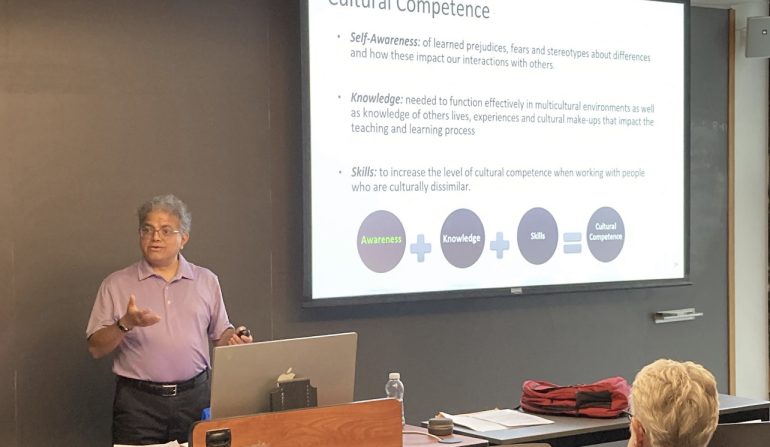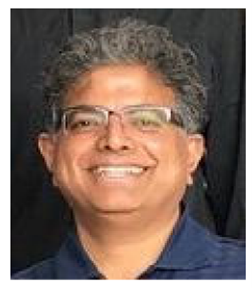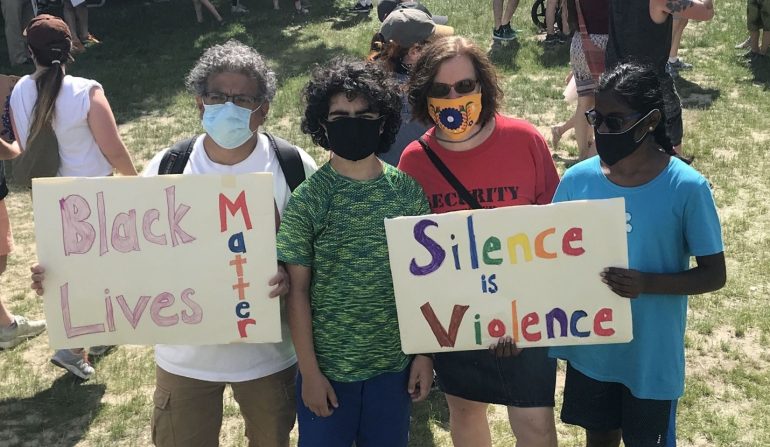
ASEE CDEI Scholar Spotlight Series: Prasad Venugopal
Dr. Prasad Venugopal
Prasad Venugopal is an Associate Professor of Physics and Affiliate Faculty in African American Studies (AAS) at the University of Detroit Mercy. In addition to teaching courses in Physics and Astronomy, he has developed and teaches a course for the AAS program – Science, Technology & Race – as part of the core curricular offerings at the university. Prasad’s research in physics education explores ways to integrate issues of race, gender, ethnicity and other culturally relevant pedagogical issues within physics curricula in order to encourage students to reflect and engage with physics in a broader social context. He serves as one of six inaugural Fellows of the American Physical Society’s Equity, Diversity, and Inclusion (EDI) Fellowship Program. Prasad’s research interests in Science & Technology Studies (STS) are at the intersection of race and/in the histories of technology. He serves as the Convener of the special interest group, Exploring Diversity in Technology’s History (EDITH), in the Society of the History of Technology (SHOT). He is a member of the Engineering Physics and Physics division of the ASEE.
Prasad is a Board member of the Michigan chapter of Peace Action, the largest grassroots peace organization in the U.S. He is also active in other local peace, labor, and anti-racism organizations, including the Ferndale Inclusion Network (Planning Committee member), the Michigan Coalition for Human Rights (Advisory Board member), and the local Metro Detroit chapter of Conversations on Race (Board member). He served as President of the University of Detroit Mercy Professors’ Union (UDMPU/MEA/NEA) for several years. Prasad is an immigrant from India, and lives in Ferndale MI, with his wife and two kids.
Can you share your story of belongingness?
My story of belongingness is one of not belonging. I came as an immigrant from India over 34 years ago. It was a learning opportunity to come from a privileged background in India, both socioeconomically and caste-wise and then to come to the United States and see some of that privilege disappear in some spaces but not in others. For example, early in graduate school, I was confronted with racism directed towards international students. Many years later, these experiences helped me understand the racial, gender and caste baggage that had shaped my own life. When I was in the doctoral program at the University of Massachusetts at Amherst, I ended up going on strike as a graduate worker, less than 3 years of arriving in this country. I cut my political teeth on a strike line! My leadership experiences in these and other campus activities gave me a sense of belonging, not necessarily in physics but within the larger social context. I learned how to be an activist on workers’ rights, immigrant rights, antiracism and antiwar issues during my graduate school years. I found a very strong sense of belonging with groups and individuals who were working on these issues. It also made me realize that there was a lot I had to learn in other areas where my privilege was invisible to me.
It’s been a continuing challenge in my career as a physicist, to take that strong sense of purpose and belonging within those communities of activism and bring it into my academic life. One of the things that attracted me to the University of Detroit Mercy was that the university had a proclaimed commitment to social justice. To be in Detroit, with its rich history of activism and struggles, and to be at a workplace that provided me the space to continue these struggles was very important to me. I’ve served as President of my faculty union, contributed to DEI and antiracism initiatives at the university, and contributed to the African American Studies and Women and Gender Studies programs. I serve on the board of local community organizations working on human rights, nuclear abolition and racial equity. And it is through these experiences that I’ve built a sense of belonging – of combining my political activism with my academic work.
What is your understanding of DEI and why it is essential to what you do?
A lot of work on diversity, equity, and inclusion is about correcting past historical wrongs, and a commitment to changing the course of society for the common good. DEI is about taking a very activist mindset and saying we need to treat people with dignity and respect. If we look at Dr. Martin Luther King Jr.’s idea of beloved communities, it was centered on questions of justice that are integral to treating people with love, dignity and respect. Not that we would ever be in a world where there is no injustice, but that our mindset and values are always focused on issues of justice. DEI is a social justice commitment with activism at its core.
The second part of why it is essential to do DEI work is that physics is among the least equitable, diverse, and inclusive of STEM fields. Physics knowledge has been created, practiced and used by people all over the world. Colonialism and racism have made it appear as the domain and property of mostly white, male Europeans. So, when I say righting past historical wrongs, it also applies to the history of physics. And the way we change it is by using the framework of equity, diversity, and inclusion. How can we change our research practices? How can we change our communal practices within the community of physicists? How can we change the way we teach? How can we change the way we present ourselves as physicists in terms of our relationship to the world out there? What are our values as physicists and how do we become more welcoming to people from all over the world?
Briefly explain the current initiatives that you are doing towards DEI.
About a year into my academic career at Detroit Mercy, I helped organize a commemoration of the Montreal massacre, where 14 female students were murdered by a male perpetrator who claimed he was “fighting feminism”. That was my awakening to the social aspects of engineering in a very specific way. This got me interested in research in science and technology studies, particularly on gender and race in technological history. One of my earliest efforts was to present a paper at the 2002 Society of Women Engineers conference. It was on issues of race, gender and environmental pollution in the electronics industry. Years later, this led to my designing a course called Science, Technology, and Race that I still teach for the African American Studies program. The course examines the ways in which science constantly recreates and reconstructs the concept of race, and how race and racial categories color research and practice in science and medicine. I see that as part of my ongoing DEI work.
One of the things that I learned from creating and teaching that course was the idea that a lot of physics education research is focused on making physics classrooms more welcoming to all students. But when it comes to changing the curriculum, we have a very hard time. The topics are traditional and even if they’re non-traditional topics, they rarely focus on issues of race, gender, and other sociocultural issues. So, I’m trying a new approach in my introductory physics class, courtesy of a great idea from my spouse! It is the project I describe in the 2022 ASEE paper that was awarded the best DEI paper award. I require my introductory physics students to read historical biographies and respond to the scientific and social issues in the story. The storytelling framework of these biographies helps highlight sociocultural issues within the context of assignments on kinematics, Newtons’ laws, conservation of energy and electromagnetism. For each assignment, students work on two parts: a physics problem created from the story, and online discussions on sociocultural issues they read about in the biographies. These integrated assignments help my students appreciate the idea, based on The Underrepresentation Curriculum Project, that “social issues and values affect the way we understand (and practice) physics and its relation to life.” My goal is to pique their interest in the role that historical and cultural factors play in the production and use of scientific knowledge.
I am currently one of six inaugural fellows of an Equity, Diversity, and Inclusion Fellowship program run by the American Physical Society. Working with other physicists and critical conversation specialists, we have designed and conducted workshops about the importance of DEI issues in physics classrooms. It has been a great learning and leadership experience to reach out to the broader physics community to build capacity and provide tools for physicists to engage in DEI conversations.
These are some DEI initiatives that I am currently involved in my work as a physicist. Most of my community activism these days is centered on racial justice and community policing initiatives. They all come together as opportunities to bring my racial and social justice activism into the sphere of physics and to help inform my teaching and research. It is important to me that being a physicist and academic not determine my role or contributions to society but rather that society determine my role and contributions as a physicist in academia.
What do you see as the next steps for your DEI work?
My goal over the next many years is to explore a lot more of the racial history of physics, of how physics has been both a racist science and an antiracist science. For physics to be more inclusive and equitable, we need to embrace DEI values, discuss what they mean for us as a community of researchers and teachers, and how we relate to racial justice struggles in society. I want to continue to change the curriculum of what I teach. Not just to be more inclusive and welcoming in my classrooms, but to change what I teach and how it relates to my students’ life experiences. Part of that, I think, is to understand and talk about the racial and gendered history of physics. I’m also collaborating with other colleagues to create a course on gender, science and society for the Women and Gender Studies program at my university.
In my community activism, I’m going to continue fighting against police brutality. I think there needs to be a radical change in the way we do policing in this country. I will also continue to work on nuclear abolition. As a physicist I bring a particular training and analytical mindset to discuss issues of nuclear abolition in my local community. And, I will always be a labor activist, fighting for the rights of workers everywhere. In the long run, I can see myself not teaching or doing physics someday, but I cannot imagine not being a social justice activist.
What recommendations do you have for engineering educators to start incorporating social justice topics in their classrooms?
I recently read an eye-opening paper co-authored by Dr. Chandra Turpen, a physicist from the University of Maryland, College Park, in which the authors analyze the ideological issues that show up in “a classroom discussion on the use of militarized drones”. AI, drones, smartphones, electric vehicles, surveillance technologies – these are important engineering innovations that we educate our students about to prepare them for successful careers. But we should be asking questions about the sociohistorical consequences of their creation and use. We have students from Yemen, Iraq or Afghanistan whose families might have been victims of U.S. militarized drones; Black and immigrant communities indiscriminately targeted by facial recognition software; smartphones powered by mining and exploitation in the Congo, and so much more. How do we bring these conversations into our classrooms and curricula? What are the ideological foundations and social justice aspects of what we teach? That’s the message I learned from the paper by Dr. Turpen and her co-authors. So, my recommendation for my engineering colleagues is this: educate yourself about these issues; expose your students to this kind of thinking; then see them light up when they recognize that what they’re learning has tremendous meaning for how they lead their lives. These are very difficult, risky conversations and we should nurture them with care for the future – our own and that of our students and colleagues. In turn, it will make us better educators and enrich our lives!

Co-leading a pilot workshop at Swarthmore College on building capacity for physicists to engage in EDI conversations in physics classrooms.
What resources can you recommend to people who want to learn more about DEI in your field?
DEI work cannot be done in isolation. It is community-based work and therefore, the first resource is to find the communities of people who are working on it. They’re never more than an arm’s length away, no matter where you work, no matter what discipline you work in. So, when you are at an ASEE meeting or other conference, go to the DEI panels because the resources are there – people, articles, ideas, communities, and collaborations you need to help you learn and do more about DEI. I have also learned much from books on Black, indigenous, women’s history and so many more. There is a reason why disciplines like engineering and physics are so inequitable and exclusive. History helps us understand the context for why things are the way they are and how we can change it. There are so many wonderful books and articles to educate ourselves, but if I had to pick one that every educator should read, it is “Why Are All the Black Kids Sitting Together in the Cafeteria: And Other Conversations About Race” by Dr. Beverly Daniel Tatum. I’m still absorbing the profound lessons from that book!
Connect with our scholar:
University website: Eswara Prasad Venugopal
Twitter: Prasad Venugopal
ASEE CDEI Communications Committee Volunteers
Volunteer Webmaster: Sarah Lester, California Polytechnic State University
ASEE CDEI Spotlight Committee Volunteers
Getting involved with CDEI
- If you want to recommend someone for our Spotlight series click here.
- Check out website Highlights:
- Resources
- Past Blogs and Events
- Compilation of Newsletters and Reports
- Connect with the committee:
- Become a Friend of the Committee
- Follow us and tag us on Twitter
- Become a volunteer on our Communications Committee! We are always looking for people that want to share or improve their writing and leadership skills.


